LONDON, Nov 10 (Reuters) – Mild weather across western Europe has helped winter wheat crops get off to a promising start but could also leave them more vulnerable to the threats posed by pests, disease or a brutal cold snap, crop analysts said on Tuesday.
Temperatures have been above normal this month in top European Union winter wheat producer France, scoring record highs over the weekend in many parts of the country.
“If frost was to arrive suddenly today all winter grain crops would be hit,” said Philippe Gate from technical institute Arvalis.
Read Also

Canadian trade data delayed by U.S. government shutdown
Canadian international trade data for September will be delayed indefinitely due to the ongoing partial shutdown of the United States government, Statistics Canada said Friday, Oct. 24.
Warm weather also favour pest development, such as slugs, and diseases carried by aphids, he said.
Freezing temperatures pose a greater threat to wheat at more advanced stages of development.
Crops in Britain also appear to be in good condition.
“It has been a fairly good autumn for planting and everything seems OK,” said analyst Jack Watts of Britain’s Agriculture and Horticulture Development Board (AHDB).
“It is pretty mild and that might give a bit of concern in terms of disease pressure but it is far too early to be talking about that in any significant context,” he added.
In Germany, the EU’s second largest wheat producer, sowings were completed on schedule in generally good conditions.
“I think the sowed area will not dramatically change from last year with a slight move towards wheat and rapeseed away from lower-priced grains like winter barley and rye,” one German analyst said, noting there could be a small rise in wheat and rapeseed area of one or two percent.
However, a drop in rapeseed area is anticipated in both Poland and Britain, analysts said.
Wojtek Sabaranski of Sparks Polska said dry weather had hindered plantings in Poland and there could be a fall in winter rapeseed sowings of about six to 10 percent to 800,000-825,000 hectares.
Several factors including low prices and the threat posed by cabbage stem flea beetle should contribute to the decline in rapeseed area in Britain, AHDB analyst Watts said.
“I wouldn’t be surprised if it (UK rapeseed area) was down by 10 percent or more,” he said.
In France early rapeseed development has been uneven in the largest producing region in the northwest of the country, oilseeds technical centre Terres Inovia said.
“We can see (in the region) plots whose growth has been constrained from the start and which will have a hard time going through winter. Several reasons for this: herbicide, flea beetles, pigeons and cool temperatures,” it said.














